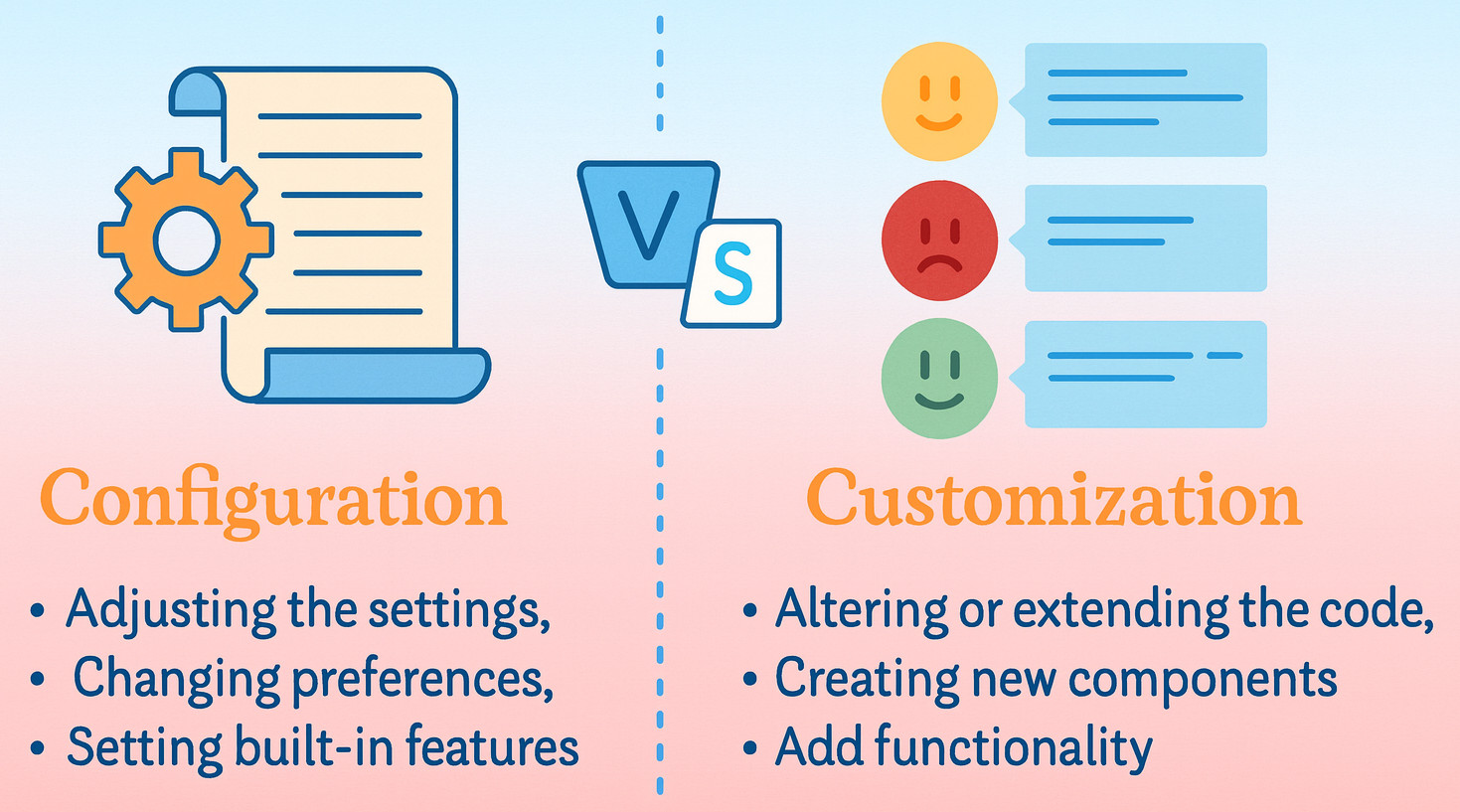Software Configuration vs. Customization
|
|
As you assess potential software solutions, you often evaluate features, functions, and pricing structures to determine which products align with your business goals. However, only finalizing these aspects is not enough. When it is time to implement the new solution, you must decide on your application’s configuration and customization options.
This article on software configuration and customization delves into these concepts and explains the key differences between the two approaches, as well as their benefits and drawbacks.
| Key Takeaways: |
|---|
|
What is Configuration in Software?
Configuration in software means adjusting a system’s settings, preferences, and built-in features to meet organizational requirements without changing the underlying code.
The changes made in the configuration change the runtime behavior and attributes of the software to support business or compliance requirements. The manufacturer supports these configuration changes, or it clearly states when they are not supported. Configurations do not require custom code to implement or change, nor do they need a developer’s kit.
Characteristics of Configuration in Software
Here are a few key characteristics of software configuration:
- Configuration relies on the software’s inherent flexibility and pre-built capabilities.
- Configuration is generally more straightforward, quicker, and less costly to implement.
- It maintains compatibility with future software updates and upgrades.
- Configuration does not require coding or specialized development skills.
- Configurations are typically done via the system’s UI, using out-of-the-box tools provided by the vendor.
Examples of Software Configuration
Here are some examples of configuration:
- Setting user roles and permissions
- Choosing default currencies, languages, or time zones
- Designing workflows using built-in process tools
- Adding custom fields or modifying form layouts via admin settings
- Setting up automated alerts or reports
- Building dashboards
- Setting team roles
- Building email templates
- Installing a plugin
Configuration is performed to adapt the existing functions to your preferences. It occurs during the software implementation process. The consultant uses the tools and applications already included in the software by the manufacturer to edit the settings, values, and functionality to suit your business.
What is Software Customization?
Customization in software means altering or extending the software’s core code or creating new components to add functionality beyond what the system offers by default.
Software customization often involves changes in the code and requires developer skills. Organizations choose software systems based on their requirements. However, sometimes, some functionality may be missing in the software system, or businesses might request new functionality if their requirements change. This is where customization comes in.
Customization enhances software functionality so that it can offer a customized user experience tailored to businesses’ specific needs.
When you say the software system is customized, it can involve adding functionality, extending a feature to encompass more functionality, or it can be as big as adding a new component to the system. Making these changes requires coding and results in fundamental changes in the codebase of the software system.
Characteristics of Customization in Software
The key characteristics of customization are as follows:
- Customization requires changes in the software’s source code.
- It is more complex, time-consuming, and expensive.
- A custom code may not be readily compatible with new versions and may complicate future upgrades and maintenance.
- Customization requires developer skills and a detailed understanding of the software system’s architecture.
Examples of Software Customization
Some of the examples of customization are:
- Writing custom scripts or plugins.
- Creating new modules from scratch.
- Adding new features like custom menus, dashboard widgets, forms, and tables.
- Integrating the system with proprietary systems using custom code.
- Modifying the background processes of database structures.
- Changing the software’s workflow logic through coding.
Customization can be a blessing and a curse. Too much customization can introduce complications with upgrades and integrations, while too little customization won’t have the desired effect on usability. Hence, it is desirable to discuss any customization with relevant stakeholders first so that they can review the business processes and help you decide on the customizations.
Configuration vs Customization
Though they appear similar, configuration and customization are two distinct processes. The following table summarizes the key differences between configuration and customization:

| Aspect | Configuration | Customization |
|---|---|---|
| Definition | Adjusting settings and features of the application without altering the source code | Modifying or extending source code to change system behavior or add functionality |
| Skill Required | User-level knowledge of software system, minimal technical expertise; often done by power users or admins | Requires software development skills and coding expertise |
| Tools/Technologies Used | System UI or Built-in tools provided by the manufacturer | Programming tools and IDEs |
| Time to Implement | Usually faster | Often slow due to coding, testing, and deployment |
| Cost | Low cost | Higher, due to development and maintenance |
| Risk | Lower or no risk of breaking the system | Higher risk of bugs and upgrade issues |
| Upgrade Impact | Configurations usually persist through updates | Customizations may require rework after updates |
| Flexibility | Limited to vendor-provided capabilities | Very flexible, can meet unique requirements |
| Maintenance | Easier to maintain, generally compatible with upgrades | More complex and resource-intensive, potential upgrade challenges |
| Complexity | Lower | Higher |
| Scope | Utilizes existing functionality | Extends or alters core functionality |
Advantages & Disadvantages of Software Configuration
| Configuration Advantages | Configuration Disadvantages |
|---|---|
| Configuration can be applied immediately using the admin tools or even the system’s UI. | Configuration has limited flexibility as it may not address highly specialized business needs. |
| Since no coding is required, it reduces developer workload. | It is bound to the vendor’s predefined feature set. |
| Configuration is much stable and less likely to break when the vendor releases updates. | |
| Configuration and its steps can be easily troubleshot as it has vendor support.. |
Advantages & Disadvantages of Software Customization
| Customization Advantages | Customization Disadvantages |
|---|---|
| Customization can fully meet unique business requirements. | Customization has higher initial and ongoing costs as it requires skilled developers. |
| It supports specialized processes that competitors can’t easily replicate, thus giving manufacturers a competitive advantage. | Vendor updates may break custom code. |
| It can successfully link with legacy systems and proprietary databases in ways that configuration alone can’t. | Changes may require ongoing support from the same developers due to customization. |
| With customization, software is closely aligned with the organization’s processes, boosting productivity. | Some vendors refuse to troubleshoot custom code issues, thus limiting the support. |
What Should You Choose – Configuration or Customization?
When deciding between configuration and customization, the following factors must be considered:
-
Business Priority: Consider the priority of the requirement. Is it the requirement that is better to have, or is it mission-critical?It depends on the priority to see if customization or configuration should be preferred.
-
Budget: The second factor is the budget. Can the organization afford the higher upfront cost or the ongoing cost of customization?Cost is a vital factor in determining whether customization or configuration is best. Customization is costlier than configuration.
-
Timeline: Is the requirement immediate, or does it have time for development and testing?If the requirement is immediate, it is better to choose a configuration, as it will not require additional time for testing, maintenance, etc. If you have ample time and you feel customization can better meet the requirement, then you should opt for customization.
-
Upgrade Frequency: What is the frequency of vendor release updates? The next question to answer is: how disruptive will the upgrades be once the requirement is completed?If customizations or configurations are too frequent, the frequency of releases also increases. Sometimes, organizations cannot cope with this. Additionally, frequent releases can disrupt their business operations, especially in the case of customization.
-
Maintenance Resources: Does the requirement need ongoing support? If yes, are skilled developers available to provide this support?A product must be maintained when customized according to the customer’s requirements. Adequate resources should be at the customer’s site to provide continuous support. Organizations sometimes lease professionals from a vendor to provide ongoing support.
-
Vendor Relationship: Will the vendor support a customized version of their product?In some cases, the vendor might refuse to support customization. In these cases, it is better to accommodate the requirements as configurations.
In CRM implementation, actions such as adjusting lead stages, creating email templates, and defining role permissions in Salesforce without adding custom Apex code are more convenient. In this case, configuration is a better choice.
In HR software systems, configuration is preferred when setting up the approval workflow for leave requests using built-in workflow tools.
In both these examples, the business needs are within the software’s existing capabilities, making configuration faster and safer.
On the other hand, in ERP integration, adding a custom module, for example, to handle industry-specific regulatory reporting, is not supported natively. Hence, this feature cannot be configured, and customization is necessary.
In manufacturing systems as well, if the requirement is for predictive maintenance, developing an algorithm that uses proprietary machine data sources is a more viable option than configuring as configuring these data sources and some options cannot achieve desired results.
Many organizations adopt a hybrid strategy, starting with maximum configuration to meet most needs, and introducing customizations only for gaps that truly affect business operations.
Future Trends
Some of the emerging trends for configuration and customization are:
- Low-Code/No-Code Platforms: These platforms let non-developers build advanced logic and integrations without writing code, leading to configurable customizations.
- API-First Architectures: APIs allow integration without disturbing or altering the core software. This reduces the need for risky code changes.
- Composable Software: These architectures use interchangeable building blocks, making adding features easier without heavy customization.
Final Thoughts
Software configuration and customization are two distinct approaches, and choosing between them is not about picking one forever; it is about making the right choice for the right requirement, considering the abovementioned factors.
Configuration should be preferred when stability, cost savings, and upgrade resilience are the main factors. Customization should be chosen for critical business processes that provide a competitive advantage and cannot be met otherwise.
In today’s modern software landscape, organizations use configuration as their foundation, customization as a strategic enhancer, and emerging low-code/no-code tools as the bridge between the two.
Additional Resources
- Open Source Software Development: The Pros and Cons
- Enterprise Software Development vs. Regular: A Clear Comparison
- Low-Code Development: Core Concepts
- How to Utilize Human-AI Collaboration for Enhancing Software Development
- The Role of QA in Agile Development
| Achieve More Than 90% Test Automation | |
| Step by Step Walkthroughs and Help | |
| 14 Day Free Trial, Cancel Anytime |












